


|
|
|
TARI, or toddy, is an all-time favourite drink of the Parsis and Iranis living in the coastal areas of South Gujarat. It is a drink they would dearly like to have everywhere they go or settle down in. Unfortunately, the palmyra tree, which is the date or coconut palm from which you get the toddy juice, does not grow easily in cities. It needs the climate of a coastal area, the soil and water, for it to blossom and fruit. In Dahanu, Gholvad and Udvada, the conditions are perfect. And almost every family has a wadi or farm in the backyard where the palmyra tree grows. From these trees, the families tap the toddy juice before dawn every day. You visit one of them for breakfast, they are more likely to offer you a glass of toddy rather than a cup of tea.
Traditionally in Dahanu and Gholvad, toddy is extracted from the palmyra tree whose fruit is the summer ice-apple commonly known as tadgola. The labourers who do the tapping are a skilled lot of Adivasis. They are known as Bhandaris, or toddy tappers. They are experts at climbing the palmyra tree. The operation is very simple. They cut the tadgola fruit in its bud and insert a small pipe into the bud. This pipe is then inserted into a matka or earthen pot that is tied beneath the fruit to the tree.
Toddy tapping generally runs in the family. How to climb the tree and how to tap toddy, is an art. They use very precise tools for the task that are created for them by blacksmiths and often procured from cobblers. They wear a leather belt that has several pouches into which these tools fit. And they strap themselves to the tree around the waist, and also the ankles, so that once up, their hands are free for them to get on with the task of slitting the tree or the fruit to fit in the pipe and to tie their pots beneath to catch the sap.
A healthy palmyra tree that is about 20 years old, can give as much as ten litres of toddy every day. The toddy tapper sells his toddy to shops and restaurants. They have contracts with several establishments that use toddy in their cooking. But the amount of toddy each of the tappers collects varies from day to day. Sometimes it is a lot, in which case the toddy is disposed cheaply to Adivasis who put up makeshift stalls on the road and sell it to thirsty people by the glass. Prohibition, in Gujarat, fortunately does not include toddy. And it is not uncommon to find even little children standing besides the Bombay-Ahmedabad highway with pots of toddy which truckers often buy off them for a small fortune. However, there are times when a tapper�s collection of toddy is not enough to meet the demand. Those are the risks they take in this small business.
These are called Neera Kendras and they are familiar sights because of their bright green colour and the attendants behind the counter who wear khakhi shorts and white topis. Each kendra stocks about seven cans of neera. The capacity of a can is 21 litres or 100 glasses. The sap for the Society�s neera is got from Gujarat and Pune. Often, the saps of the palmyra-tadgola tree and the date tree are mixed so that the neera is extra sweet. And the Society also cheats by mixing some calcium in the sap, so that neera does not ferment and become toddy during the day. A 200 ml glass of neera at any of the kendras costs Rs. 4.
The Parsis and Iranis believe that their tari has great medicinal values as well. They make Ooni Keetheli Tari, which is a mixture of warm toddy with ginger and jaggery, that is said to be an excellent cure for upset stomachs. A large glass of toddy is mixed with a tablespoon of jaggery, one clove of crushed garlic, and a pinch of coarsely ground black pepper. The ingredients are heated in a pan, stirring constantly, until the jaggery is dissolved. It is had warm. And they use tari in the food as well. Several dishes that can be fermented with baking powder or yeast, are made with toddy instead. The boomla, or Bombay Duck, for example. It is rubbed with gram flour, oil and ground spices like garlic, cumin seeds, dried red chillies, jaggery and vinegar and cooked in a clay pot in toddy for about 20 minutes. Parsis who have their boomla this way, will not have it in any other preparation!
|

Home Page
About the mag
Subscribe
Advertise
Contact Us

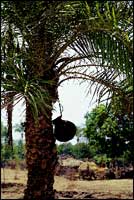 Getting A Kick Out Of Toddy!
Getting A Kick Out Of Toddy!
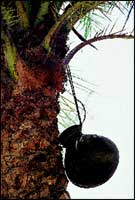 In its early avatar, toddy is known as neera. And it is a refreshing and light drink, extremely cool in sensation, and sugary sweet to taste, like a palm juice. Which it is, because all the trees that can be tapped for toddy are from the palm tree family, including the date palm and coconut palm. When the tree is tapped before dawn, and the fresh and slightly fermented juice is consumed, say, before 10 o�clock, it is a delightful drink. In its pure and natural form, neera is supposed to be extremely good for the health. When the tree is tapped a little after sunrise, then the juice is fermented and sour, and this is toddy. This juice gets increasingly heady as the day advances. To the extent that a glass of undiluted toddy can even be considerably intoxicating to the uninitiated.
In its early avatar, toddy is known as neera. And it is a refreshing and light drink, extremely cool in sensation, and sugary sweet to taste, like a palm juice. Which it is, because all the trees that can be tapped for toddy are from the palm tree family, including the date palm and coconut palm. When the tree is tapped before dawn, and the fresh and slightly fermented juice is consumed, say, before 10 o�clock, it is a delightful drink. In its pure and natural form, neera is supposed to be extremely good for the health. When the tree is tapped a little after sunrise, then the juice is fermented and sour, and this is toddy. This juice gets increasingly heady as the day advances. To the extent that a glass of undiluted toddy can even be considerably intoxicating to the uninitiated.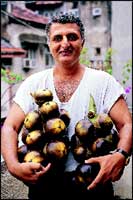 Toddy tappers climb the tree in the evening to rig the pots up and then they go up next morning, to collect the toddy. It collects in the pot after dripping all night in the form of a milky white, translucent sap. Toddy tappers say that the best sap is got from those trees that are just flowering. However, they also tap those trees that are bearing fruit.
Toddy tappers climb the tree in the evening to rig the pots up and then they go up next morning, to collect the toddy. It collects in the pot after dripping all night in the form of a milky white, translucent sap. Toddy tappers say that the best sap is got from those trees that are just flowering. However, they also tap those trees that are bearing fruit.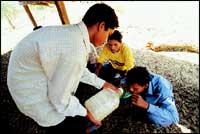 The toddy tappers have yearly contracts with the Parsi-Irani families in Dahanu and Gholvad. They pay the families a sum of money depending on the number of trees in the wadi from which they can tap toddy. And, after giving the family a small percentage of the toddy, they take the rest away for sale.
The toddy tappers have yearly contracts with the Parsi-Irani families in Dahanu and Gholvad. They pay the families a sum of money depending on the number of trees in the wadi from which they can tap toddy. And, after giving the family a small percentage of the toddy, they take the rest away for sale. 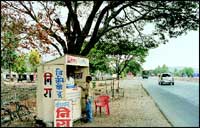 Outside of coastal Gujarat, it is neera that is more popular than toddy. In cities such as Bombay and Pune, the Maharashtra Rajya Khadi Gramodyog Commission has almost made toddy tapping and selling of neera a small scale industry. It has created the Neera Palm Product Cooperative Society which sets up small green kiosks on all major railway stations, and every few kilometres on the highways and expressway, that sell neera.
Outside of coastal Gujarat, it is neera that is more popular than toddy. In cities such as Bombay and Pune, the Maharashtra Rajya Khadi Gramodyog Commission has almost made toddy tapping and selling of neera a small scale industry. It has created the Neera Palm Product Cooperative Society which sets up small green kiosks on all major railway stations, and every few kilometres on the highways and expressway, that sell neera. 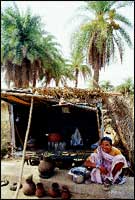 The monsoon months in Dahanu and Gholvad are bad for the toddy tappers. This is a lean period for them and they don�t make any money at all. They don�t climb the trees in the rains because the trunks of the palmyra get very slippy and are covered with moss. Taking the risk of climbing could mean a fatal accident. But, from October to June, they do good business. They will continue to tap a palmyra until it cannot bear the tadgola fruit anymore. Then the toddy tapper leaves it and moves on. The tree continues to live but is is barren. Some of the Parsi-Irani families do not use their palmyra trees for the toddy. They are more interested in the tadgola fruit instead. This is a fruit that is as tropical as the coconut and as cooling as, well, the ice-cream! The fruit comes in a hard, black shell that has to be cracked so that the oval flesh inside can be scooped out and consumed. People like their tadgolas differently. Some prefer the hard and firm fruit while others like it soft and mushy. Eat it fresh, then it is fleshy and juicy, though the tadgola can be kept refrigerated for days. It remains.
The monsoon months in Dahanu and Gholvad are bad for the toddy tappers. This is a lean period for them and they don�t make any money at all. They don�t climb the trees in the rains because the trunks of the palmyra get very slippy and are covered with moss. Taking the risk of climbing could mean a fatal accident. But, from October to June, they do good business. They will continue to tap a palmyra until it cannot bear the tadgola fruit anymore. Then the toddy tapper leaves it and moves on. The tree continues to live but is is barren. Some of the Parsi-Irani families do not use their palmyra trees for the toddy. They are more interested in the tadgola fruit instead. This is a fruit that is as tropical as the coconut and as cooling as, well, the ice-cream! The fruit comes in a hard, black shell that has to be cracked so that the oval flesh inside can be scooped out and consumed. People like their tadgolas differently. Some prefer the hard and firm fruit while others like it soft and mushy. Eat it fresh, then it is fleshy and juicy, though the tadgola can be kept refrigerated for days. It remains.  Some Parsis are also known to do a drumsticks dish in toddy. The drumsticks are heated in a pan with ghee and ground spices and then simmered with toddy for a while. In the monsoon months when toddy is not available, these families use beer instead! And they use toddy in meat and chicken dishes as well. But this toddy must be sour. Parsi bakers use toddy in the doughnuts called Bhakra. While some use toddy like Gujaratis use yogurt, to make a Tari Ni Kudhi. Served with khichdi, papads and pickle, it makes a very delightful dish. The recipe for this Kudhi is simple. You will need:
Some Parsis are also known to do a drumsticks dish in toddy. The drumsticks are heated in a pan with ghee and ground spices and then simmered with toddy for a while. In the monsoon months when toddy is not available, these families use beer instead! And they use toddy in meat and chicken dishes as well. But this toddy must be sour. Parsi bakers use toddy in the doughnuts called Bhakra. While some use toddy like Gujaratis use yogurt, to make a Tari Ni Kudhi. Served with khichdi, papads and pickle, it makes a very delightful dish. The recipe for this Kudhi is simple. You will need: